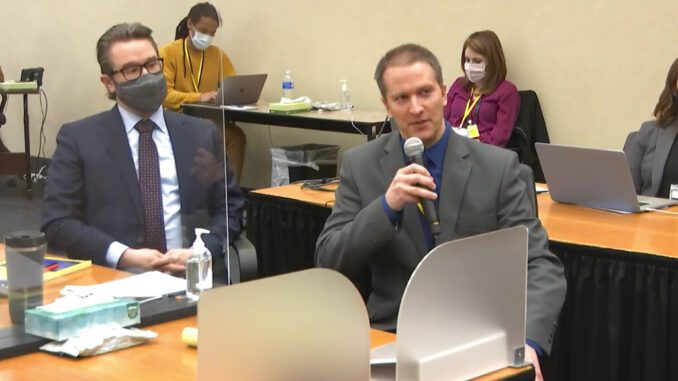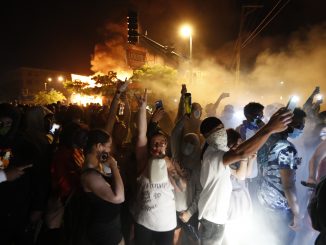
MINNEAPOLIS — Former Minneapolis police Officer Derek Chauvin removed his mask in court Monday for only the second time during his murder trial in George Floyd ‘s death.
For much of the rest of the trial, the mask — necessary because proceedings are taking place during the coronavirus pandemic — hid Chauvin’s reaction to testimony, including any signs of sympathy or remorse that legal experts said could make a difference to jurors.
Chauvin, wearing a light gray suit with a blue shirt and blue tie, removed his mask Monday while his defense attorney presented closing arguments to jurors. While prosecutors made theirs, though, he kept his mask on with his eyes mostly focused on taking notes.
Chauvin elected to not testify in his own defense, so the enduring image of him has been his impassive expression from last May captured on video by a teenager who filmed him holding Floyd to the ground for 9 minutes, 29 seconds. The girl called Chauvin’s stare “cold” and “heartless.”
Prosecutors repeatedly displayed the image to the courtroom, and Minneapolis Police Chief Medaria Arradondo alluded to the white former officer’s facial expression as he explained how he had violated department policy by kneeling on the Black man’s neck for so long.
Legal experts said that image — and the challenge of replacing it in jurors’ minds with Chauvin’s reactions during trial — may have hampered the defense.
“Every trial has a hero and a villain,” said Ryan Pacyga, a defense attorney who followed the trial. “He looks like a villain.”
Trial lawyers, who have long practiced the art of courtroom dramaturgy, send subtle hints to jurors about a defendant through their looks and body language. They say it’s important because it humanizes the defendant.
“You’ve got to find a way for the jury to care for them,” Pacyga said.
HOW DID JURORS SEE CHAUVIN?
The question was important to Chauvin’s defense before the trial even began. His defense attorneys attempted to weed out potential jurors who had already formed strong opinions about him. Jurors then watched video of Floyd’s arrest and heard from witnesses who expressed strong feelings about Chauvin.
“He didn’t care. It seemed as if he didn’t care what we were saying,” said 18-year-old Darnella Frazier, one of several witnesses who testified through tears.
Chauvin didn’t show any obvious emotion during the videos or testimony as he scribbled notes on a notepad. But it was difficult to see if he was affected because the bottom half of his face was obscured by his mask.
“I wonder if watching these videos causes him some pain and agony? I don’t know,” Joseph Daly, emeritus professor at Mitchell Hamline School of Law in St. Paul, Minnesota, told The Associated Press during the trial.
WHY IS A DEFENDANT’S REMORSE IMPORTANT?
Research by legal scholars has shown that defendants who appear remorseful may have an advantage with juries.
“People who look more angry are more likely to be viewed as being a criminal,” said Kim MacLin, a professor at the University of Northern Iowa who specializes in psychology and law.
She conducted an experiment that found jurors in a mock trial were more likely to acquit if they saw an image of the defendant that seemed remorseful. Other research has shown that juries deciding whether to sentence someone to death are more lenient when a defendant seems to show remorse.
“It is something that juries, by human nature, think about. What sort of person are we dealing with here?” said Susan Bandes, an emeritus professor at DePaul University College of Law.
She noted that Chauvin already has a “remorse deficit” due to his demeanor during Floyd’s arrest, adding: “That look on his face as captured in the video is so powerful.”
Defense attorneys often try to cast defendants in a positive light by having them wear a suit that fits, getting them to smile during breaks in proceedings or asking their family or friends to appear in the courtroom.
Chauvin’s defense attorney touched him on the shoulder while he was introduced during jury selection, when Chauvin was allowed to briefly take his mask off.
Daly said it is a way for the attorney to send a subtle message to jurors: “I’m not afraid of this guy.”
WHY DIDN’T CHAUVIN TESTIFY?
Legal experts said Chauvin’s attorney, Eric Nelson, had a lot to consider when deciding whether to put Chauvin on the stand. On Thursday, Chauvin and Nelson told the court it was a difficult decision but that the former officer would not testify in his own defense.
They did not explain how they reached that decision.
Testifying would have given Chauvin a chance to remove his mask and try to present a more likeable side.
“You’ve got to get this jury in Chauvin’s shoes in some way, shape or form,” Pacyga said earlier in the trial. “Otherwise he looks like the most callous person in the world.”



